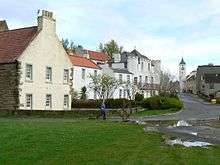West Wemyss
West Wemyss (/wɛst wiːmz/ (![]()
History
The village of West Wemyss began as a settlement around the site of Wemyss Castle which developed into a centre for the salt industry in the area.[1][4] An epidemic of plague arrived in Scotland in July 1584, brought to West Wemyss in a ship called a crayer.[5][6]
A harbour was later built in 1621 by the Wemyss family for the use of coal exportation from the pits on the lands of their estate.[3] The harbour would become a major export point for coal by the late 17th century.[3] The ships brought back imports of wood, iron and flax from the Baltic Countries.[3] A wet dock was added for the increased demand of the coal in the 1870s.[3] Towards the latter stages of the 19th century, the village found itself surrounded by several mines - such as the Michael Pit in nearby East Wemyss.[7] The industry, which saw trade with England and The Low Countries, started to struggle once the new docks were opened in Methil further along the Fife coast. Gradually, the demand for the harbour began to fall and it went into decline.[7] The harbour has since been filled in and part of the old village restored,[3] becoming a conservation area with several attractive buildings.[7] William Angus Knight, Professor of Moral Philosophy at St Andrews University, editor and biographer of William Wordsworth, lived here as a child from 1844.
The manse in the village was rebuilt in 1894 to a design by Robert Lorimer.[8]
Present day
The West Wemyss development trust have been pivotal in the re-creation of village services. A 2009 report[9] identified various options for the Wemyss Arms, a disused pub. In 2012 the building has been re-opened as a bistro, cafe, shop and bunkhouse, providing much needed local facilities.[10]

References
Notes
- Lamont-Brown Fife in History and Legend pp.151–152.
- "Population Estimates for Towns and Villages in Fife" (PDF). Fife Council. March 2008. Archived from the original (PDF) on 9 June 2011. Retrieved 5 September 2009.
- Fife Regional Council The Coast of Fife pp.37–38.
- Omand,Donald The Fife Book p.195.
- David Masson, Register of the Privy Council of Scotland: 1578-1585, vol. 3 (Edinburgh, 1880), pp. 679, 690, 695.
- Shrewsbury, J. F. D. (10 November 2005). "A History of Bubonic Plague in the British Isles". Cambridge University Press – via Google Books.
- Pearson, John M., Around Kirkcaldy p.31.
- Dictionary of Scottish Architects: Robert Lorimer
- Feasibility Study For A Community Hub Building. The Pool. September 2009.
- Bucking the trend Scottish Community Alliance.
| Wikimedia Commons has media related to West Wemyss. |